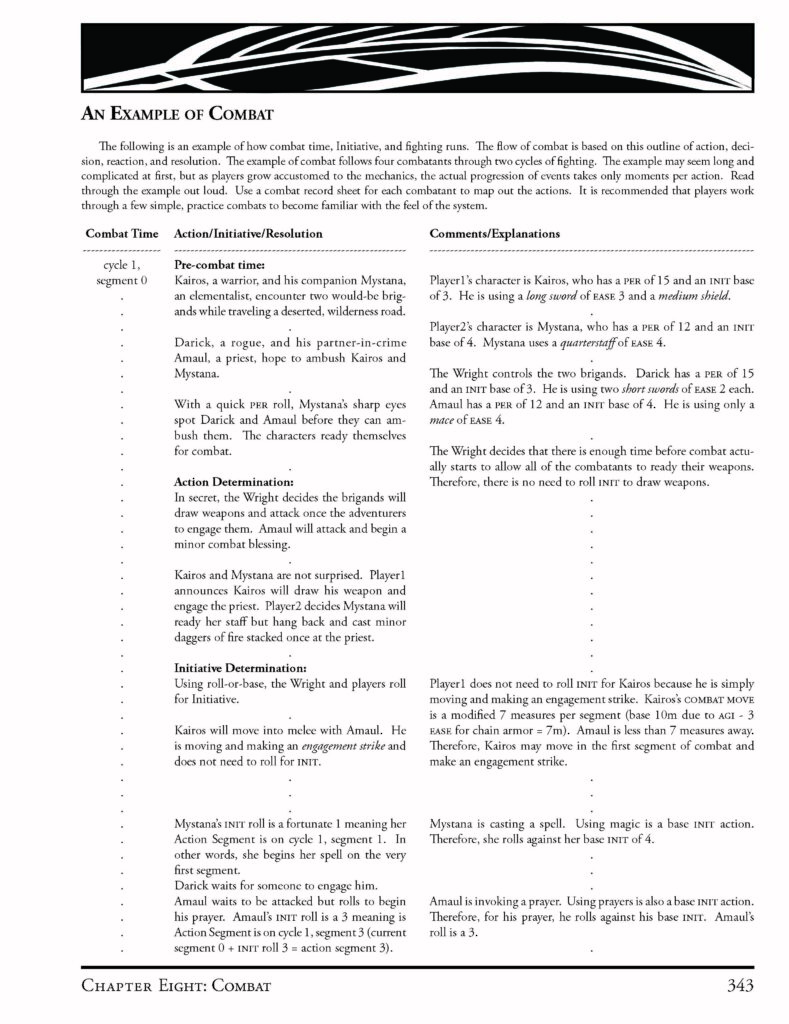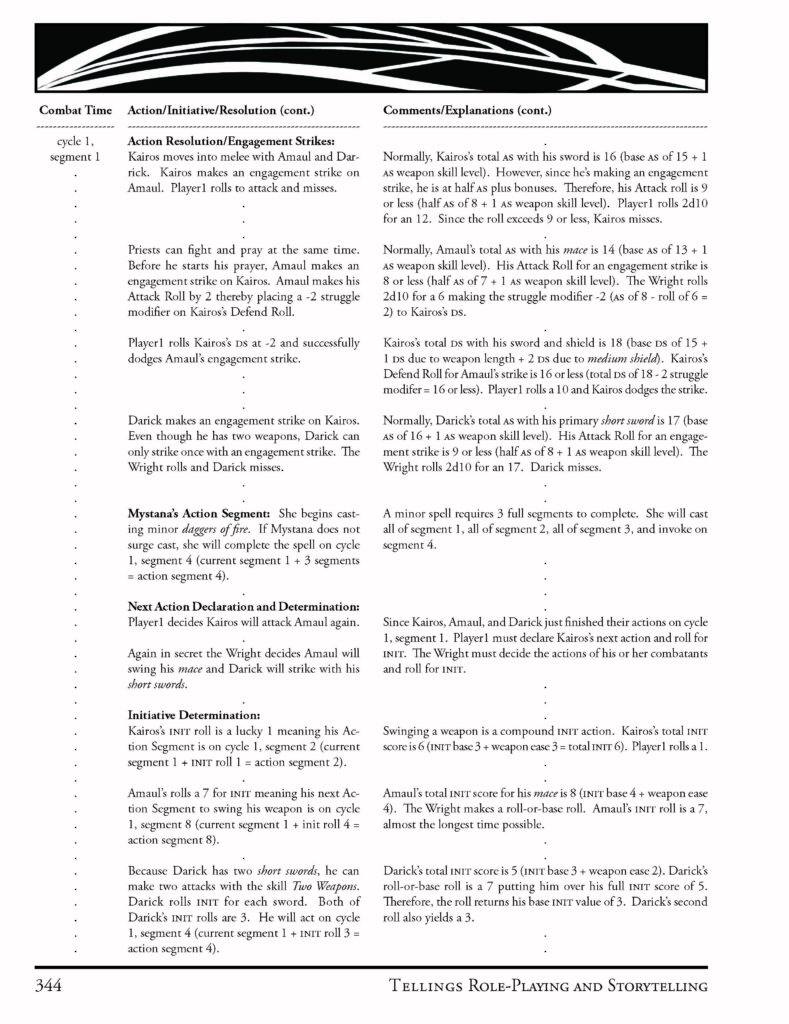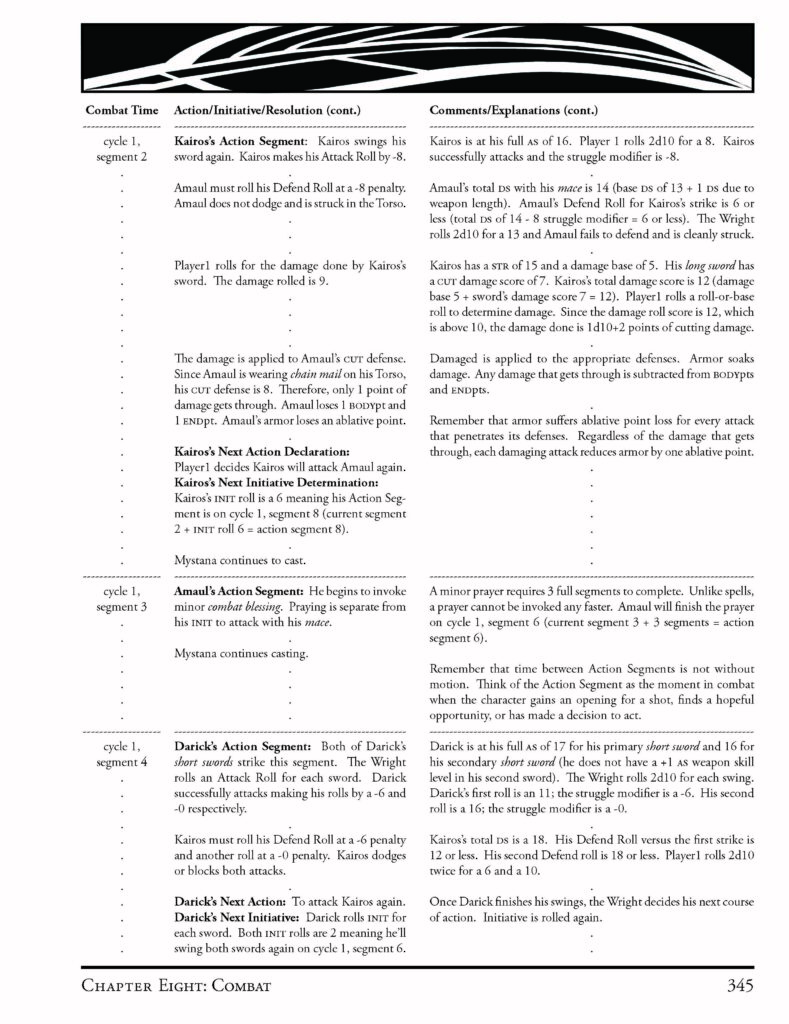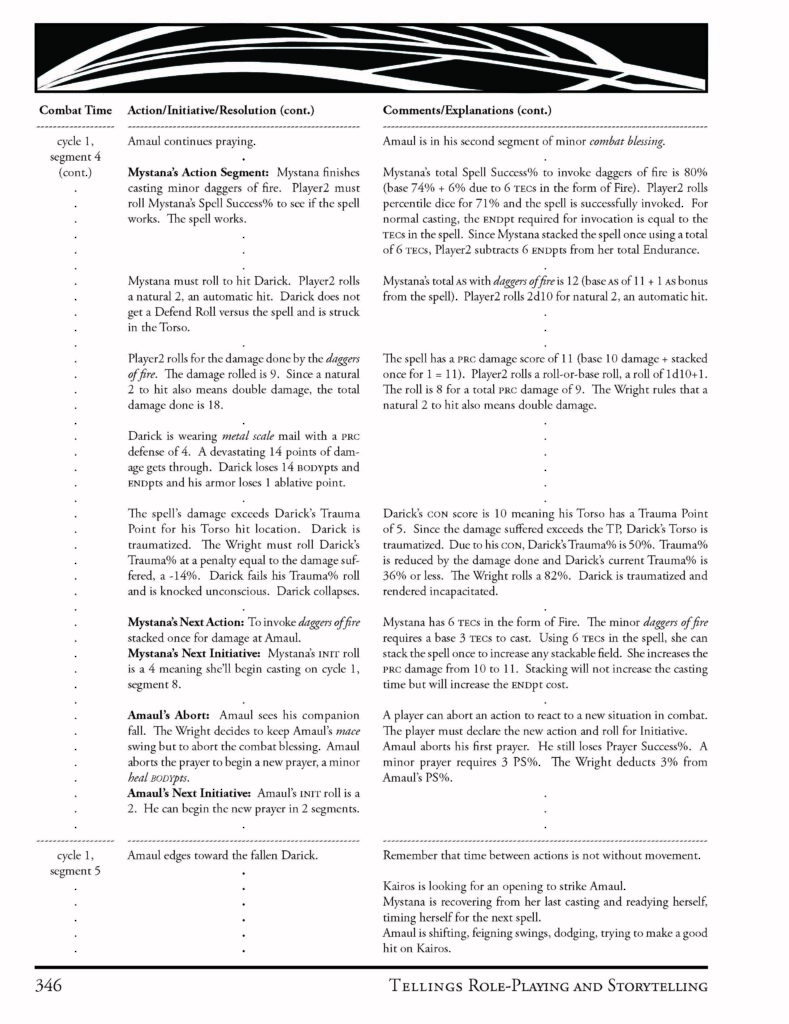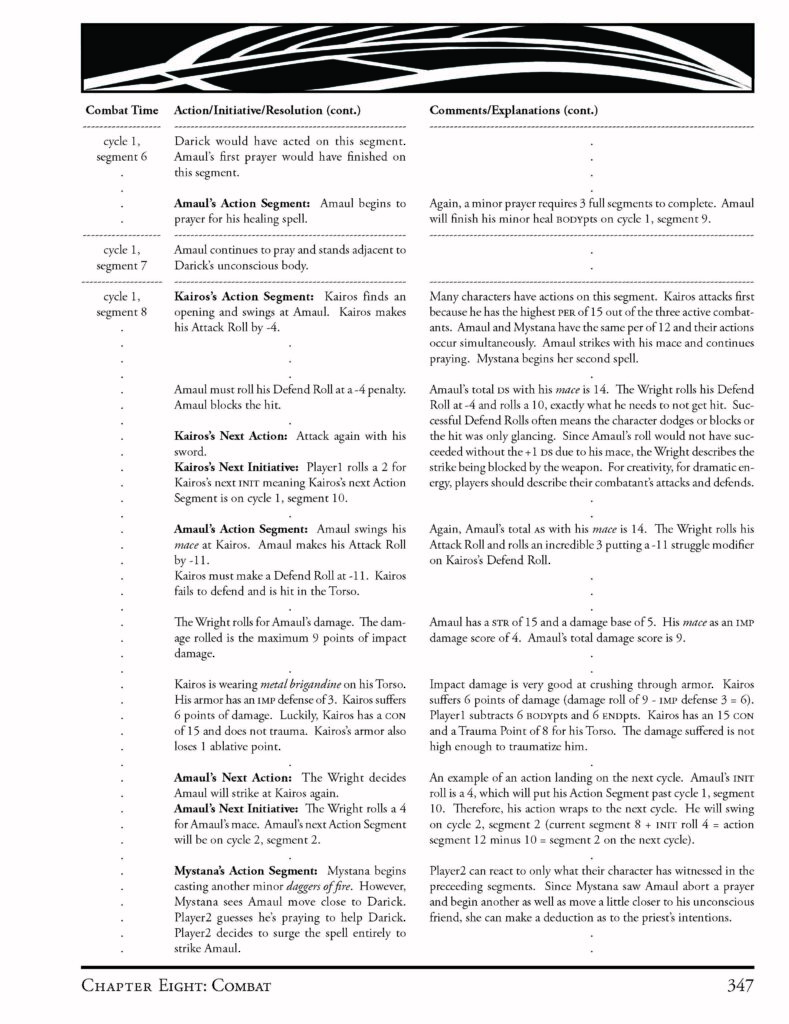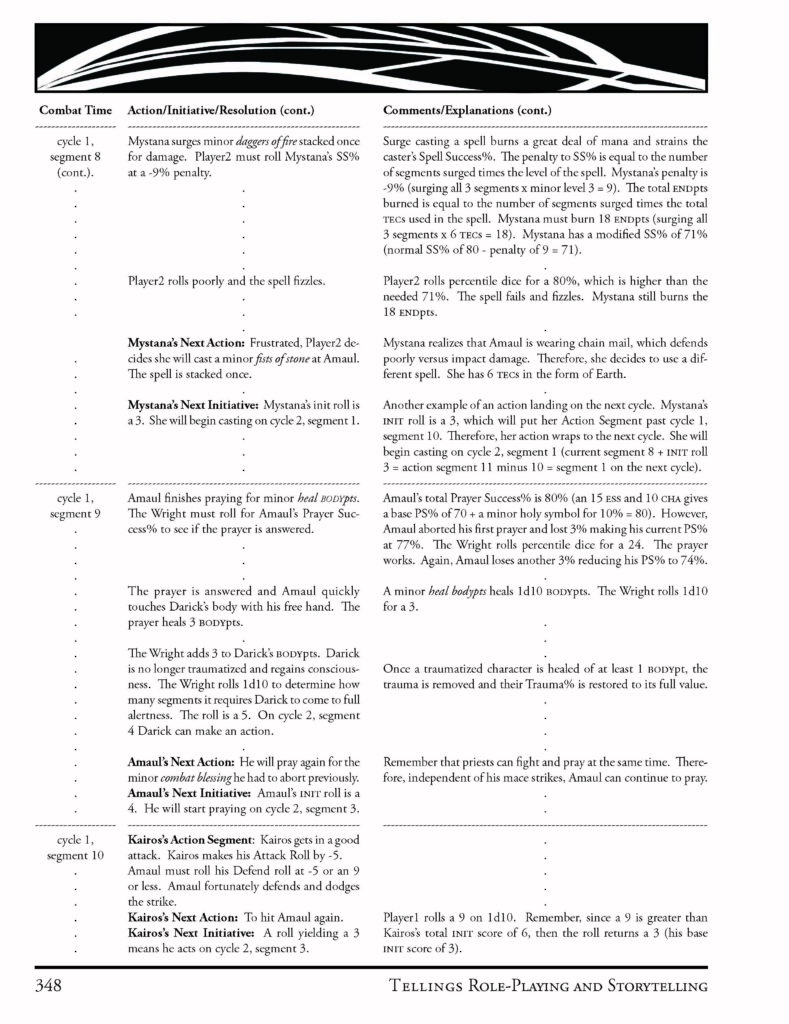
As the adventure unfolds, the character will encounter many different people, many different things, and many different obstacles. The character will find old friends, meet new allies, and make new enemies. Every step, every turn, every chance leads the character to discovery, to challenge, and sometimes to battle.
When words and reason fail, sometimes only skill and steel remain. And when conflict cannot be solved through diplomacy or guile, sometimes resolution can only come through the crossing of swords.
Whether it is a street brawl, a barroom fight, a tournament joust, a military melee, or a duel of magic, all combat is a combination of thought, skill, movement, and strength. The Tellings combat system strikes a balance between the detail of realism and the speed of playability, between the hectic flow of fighting and the fierceness of combat moves and mechanics. One of the greatest strengths of Tellings is the fluid-time combat system. Below are excerpts from Chapter Four on combat.
Fluid-Time Combat
What is fluid-time combat? What makes it different from action-round combat?
In most other RPGs, combat is organized into rounds of time where each combatant is given an action per round. A round is usually a minute of fighting. Within a round, a combatant can swing a weapon, move, use a skill, or cast a spell. A round is usually divided in to shorter segments. Depending on initiative, reaction speed, and weapon ease, a character’s action falls on a particular segment in a round. Therefore, the fastest combatant will go first in the round and the slowest combatant will go at the end of the round. Each combatant is given their action and the next round is started.
Action-round combat attempts to give each character their due in combat. Every combatant gets a chance each round. However, the only advantage, though significant, to a fast reaction time or fast weapon or a short spell is getting a head start at the beginning of a round. The fastest combatant, making his or her move right from the start, must wait for the slowest combatant to end the round before a new action can be made.
Even in a combat system where action is not organized strike by strike or move by move, a thoughtful game must and should reflect that a character with a dagger should attack more often in succession than a character with a great sword. Or, for example, a mage or priest invoking magic, which takes only a few segments, must wait till the next round before starting, even considering another spell or prayer.
Therefore, fluid-time combat allays some of the difficulties and smoothes out some of the rigid structure of action-round combat. In fluid-time combat, once a combatant finishes an action, he or she immediately begins another in concert and in parallel with what the other combatants are doing. Initiative, decision, and resolution for each player and character is determined semi-independently from other initiatives. Action follows action. Movement follows movement. The continuity of combat time is preserved. Under the auspices of fluid-time combat, a dagger will strike several times before a great sword makes a single blow. A mage or priest can invoke their magics effectively and efficiently. A fast character will have a measurable advantage over a slow character.
Combat Time
Combat time is measured in segments. A segment is approximately six seconds. And ten segments equals a combat cycle or one minute.
Combat begins on cycle 1, segment 0. Time is ticked by as the Wright counts off the segments. Cycle 1, segment 1. Cycle 1, segment 2. Segment 3. Segment 4. Segment 5 and so on. When the count reaches segment 10, time simply continues and wraps to the next minute, to cycle 2, segment 1.
Remember that the organization of combat on paper is just a representation. Real combat is always the heat of action, the blur of strikes and counterstrikes, the chaos of fighting, and the ebbs and flows of running, stillness, and running again. Time and movement are continuous, always churning. Combat is not like a chess game. The character’s action for a particular segment is just one of a many actions left to the player’s imagination. Combat time is filled with posing, feigned strikes, maneuverings, dodges, glances, and misses. The character’s action segment represents an instant opportunity, a memorable feat, an open shot, or a lucky blow.
Just because a character makes a move or strike or finishes a spell does not mean the character comes to a silent stop. Combat is highly complex and constantly flowing. The Tellings system highlights a combatant’s actions. Move, parry, strike. Block, dodge, run. Pray, cast, shout. Therefore, whenever a character makes an action, it is like a flashbulb picture seen only for a moment and fades till the next flash, till the next roll of the dice.
The Combatant’s Cycle
Once the battle cry is sounded, once swords are unsheathed, once the voice or the oath is heard, combat is begun. The combatant’s actions are mapped by a cycle of player decisions, dice rolls, and game resolutions. Each player is responsible for keeping track of his or her own character’s actions and reactions. The combatant’s cycle consists of the following: action determination, initiative determination, and action resolution. As combat continues, each character repeats the cycle of action, initiative, and resolution.
Action Determination
Before any dice are rolled, before Initiative is determined, the actions of every combatant must be decided. Usually, a full action is to move, to attack with a weapon, to cast or invoke a prayer, to get an item out of a pack, or to use a skill. Proficiencies, combat maneuvers, and special abilities may allow the character to perform simultaneous actions.
The Wright decides in secret what the NPCs and monsters are going to do. Each player decides what his or her character is going to do. Remember that combatants can only react to actions already begun or in progress at the time of determination. Furthermore, the only time all the combatants, the Wright, and player characters alike always share the same action determination segment is at the start of combat. Once the initial actions are resolved, each combatant will act and react separately.
Initiative Determination
Once the character’s action is decided, the player rolls for the character’s Initiative. Initiative determines when or how fast the character can act and react in combat. An Initiative roll determines the segment on which the character makes or completes his or her action. See the following section on Initiative for details.
Generally, most actions are adjudicated by an INIT roll. However, some actions are independent of Initiative. In addition, an action that takes no time requires only a fraction of a segment to perform and usually can be done regardless of Initiative. See the following sections for details.
Action Resolution
On the combatant’s Action Segment, the character’s attack is made, damage is determined, his or her movement done, their skill is used, or a spell or prayer is begun. Some actions are completed upon the Action Segment such as making an attack or a combat move. However, some actions are begun on the Action Segment and require additional segments to complete such as casting, praying, surveying the situation, retrieving an item, or using a skill in combat. See the section on fighting and other actions in combat for details.
Once the combatant’s action is completed, the player must declare the character’s next action and the combatant’s cycle repeats.
A Few Pages of Action
Below is an excerpt of “An Example of Combat” from Chapter Eight of the Tellings rule book:
